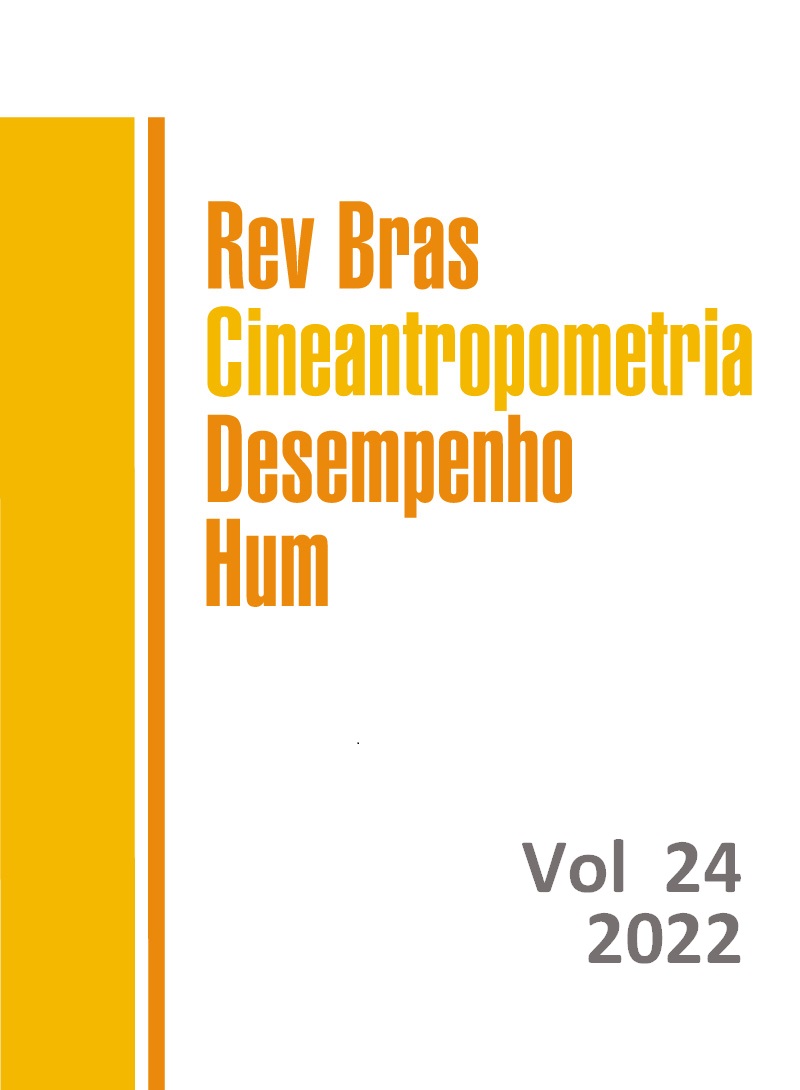Can body mass index influence the skin temperature of adolescents? A preliminary study with the use of infrared thermography
DOI:
https://doi.org/10.1590/1980-0037.2022v24e89769Keywords:
Adiposity, Adolescent, Body Composition, Body temperature regulationAbstract
Infrared thermography (IRT) has been used to assess skin temperature (Tsk), especially during the COVID-19 pandemic, as an important tool in medical screening not only of the general population, but also of young athletes. However, the subcutaneous adipose tissue can act as an insulator when the Tsk is assessed by IRT, modifying the normal Tsk data and leading to their misinterpretation. Considering that the body mass index (BMI) is an important predictor of obesity, the objective of this study was to verify if the Tsk measured by IRT is affected by the BMI in adolescents. A preliminary study was carried out being four participants intentionally selected, all 16 years old, each one classified in a different BMI range according to the criteria of the World Health Organization for the adolescent population: underweight, healthy weight, overweight and obesity. Four thermograms of each participant were recorded and the ThermoHuman® software was used to evaluate 82 regions of interest (ROI), which were integrated into 6 body regions. Using healthy weight subjects as a reference, it was found a progressive reduction in Tsk in all ROI compared to overweight and obese participants, with emphasis on the anterior region of the trunk (3.04% and 6.69 % less respectively), and an increase in the Tsk of all body regions for the underweight subject. There are indications that BMI can influence the Tsk value in adolescents and should be taken into account when analyzing thermograms for a correct evaluation of thermal normality.
References
Lahiri BB, Bagavathiappan S, Jayakumar T, Philip J. Medical applications of infrared thermography: A review. Infrared Phys Technol [Internet]. 2012;55(4):221–35. Available from: http://dx.doi.org/10.1016/j.infrared.2012.03.007
Perpetuini D, Filippini C, Cardone D, Merla A. An overview of thermal infrared imaging-based screenings during pandemic emergencies. Int J Environ Res Public Health. 2021;18(6):1–12.
Shimatani A, Hoshi M, Oebisu N, Iwai T, Takada N, Nakamura H. Clinical significance of thermal detection of soft-tissue tumors. Int J Clin Oncol [Internet]. 2020;25(7):1418–24. Available from: https://doi.org/10.1007/s10147-020-01658-1
dos Santos JC, Moreira TMM. Risk factors and complications in patients with hypertension/diabetes in a regional health district of northeast Brazil. Rev Esc Enferm USP. 2012;46(5):1125–32.
Fernández-Cuevas I, Bouzas Marins JC, Arnáiz Lastras J, Gómez Carmona PM, Piñonosa Cano S, García-Concepción MÁ, et al. Classification of factors influencing the use of infrared thermography in humans: A review. Infrared Phys Technol. 2015;71:28–55.
Castellani JW, Young AJ. Human physiological responses to cold exposure: Acute responses and acclimatization to prolonged exposure. Auton Neurosci. 2016;196:63–74.
Marins JCB, Fernandes AA, Cano SP, Moreira DG, da Silva FS, Costa CMA, et al. Thermal body patterns for healthy Brazilian adults (male and female). J Therm Biol [Internet]. 2014;42(1):1–8. Available from: http://dx.doi.org/10.1016/j.jtherbio.2014.02.020
Neves EB, Salamunes ACC, de Oliveira RM, Stadnik AMW. Effect of body fat and gender on body temperature distribution. J Therm Biol [Internet]. 2017;70:1–8. Available from: https://doi.org/10.1016/j.jtherbio.2017.10.017
Salamunes ACC, Stadnik AM, Neves EB. The effect of body fat percentage and body fat distribution on skin surface temperature with infrared thermography. J Therm Biol [Internet]. 2017;66(November 2016):1–9. Available from: http://dx.doi.org/10.1016/j.jtherbio.2017.03.006
Chudecka M, Lubkowska A, Kempińska-Podhorodecka A. Body surface temperature distribution in relation to body composition in obese women. J Therm Biol. 2014;43(1):1–6.
Chudecka M, Lubkowska A. Thermal imaging of body surface temperature distribution in women with anorexia nervosa. Eur Eat Disord Rev. 2016;24(1):57–61.
De Onis M, Onyango AW, Borghi E, Siyam A, Nishida C, Siekmann J. Development of a WHO growth reference for school-aged children and adolescents. Bull World Health Organ. 2007;85(9):660–7.
Marins JCB, Formenti D, Costa CMA, De Andrade Fernandes A, Sillero-Quintana M. Circadian and gender differences in skin temperature in militaries by thermography. Infrared Phys Technol [Internet]. 2015;71:322–8. Available from: http://dx.doi.org/10.1016/j.infrared.2015.05.008
Costa CMA, Sillero-Quintana M, Piñonosa Cano S, Moreira DG, Brito CJ, Fernandes AA, et al. Daily oscillations of skin temperature in military personnel using thermography. J R Army Med Corps. 2016;162(5):335–42.
Marins JCB, Fernandes AA, Cano SP, Moreira DG, da Silva FS, Costa CMA, et al. Thermal body patterns for healthy Brazilian adults (male and female). J Therm Biol [Internet]. 2014;42(1):1–8. Available from: http://dx.doi.org/10.1016/j.jtherbio.2014.02.020
Lemieux S, Prud’homme D, Bouchard C, Tremblay A, Despres JP. Sex differences in the relation of visceral adipose tissue accumulation to total body fatness. Am J Clin Nutr. 1993;58(4):463–7.
Zaproudina N, Varmavuo V, Airaksinen O, Närhi M. Reproducibility of infrared thermography measurements in healthy individuals. Physiol Meas. 2008;29(4):515–24.
Zhu WP, Xin XR. Study on the distribution pattern of skin temperature in normal Chinese and detection of the depth of early burn wound by infrared thermography. Ann N Y Acad Sci. 1999;888:300–13.
Kolosovas-Machuca ES, González FJ. Distribution of skin temperature in Mexican children. Skin Res Technol. 2011;17(3):326–31.



